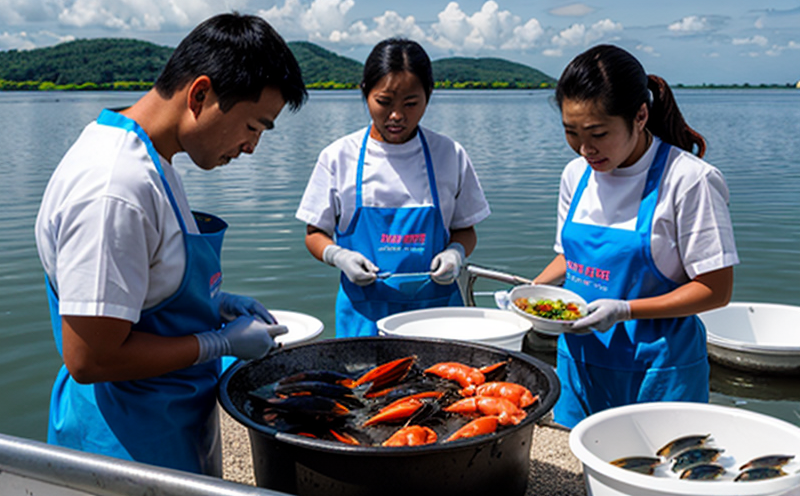ISO 21426 Chromium Quantification in Seafood
The quantification of chromium in seafood as per ISO 21426 is a crucial process for ensuring food safety and regulatory compliance. This standard provides detailed guidelines on the methodologies to accurately measure total chromium concentrations, which are essential for identifying potential contamination risks.
Chromium, while essential at trace levels, can become toxic in higher amounts. In seafood, elevated levels of hexavalent chromium (Cr(VI)) have been linked to various health concerns, including carcinogenic effects. Therefore, accurate quantification is paramount for maintaining food safety standards and ensuring consumer protection.
The process begins with the collection and preservation of samples, which should be done following strict protocols to prevent contamination or degradation. Once collected, the samples are often digested using strong acids before being analyzed via atomic absorption spectrophotometry (AAS) or inductively coupled plasma mass spectrometry (ICP-MS), both methods compliant with ISO 21426.
The standard specifies that sample digestion should be performed under controlled conditions to ensure reproducibility. The digested samples are then analyzed using AAS, which is suitable for low concentration levels of chromium, or ICP-MS for more accurate quantification across a broader range of concentrations. Both methods must comply with the precision and bias requirements outlined in ISO 21426.
Understanding the implications of chromium contamination requires knowledge of permissible limits as set by international standards such as Codex Alimentarius, EU directives, and others. These limits vary based on the type of seafood and its intended use (e.g., human consumption or animal feed). Compliance with these limits ensures that products meet regulatory requirements and can be safely marketed.
| Type of Seafood | Permissible Chromium Limit (mg/kg) |
|---|---|
| Shellfish | 0.5 |
| Fish Fillets | 1.0 |
| Crustaceans | 0.7 |
The quantification process is not only about detecting the presence of chromium but also about identifying its form, as different forms have varying degrees of toxicity. This information is critical for understanding the full risk profile associated with a particular batch of seafood.
Furthermore, ISO 21426 emphasizes the importance of traceability and documentation throughout the testing process. Detailed records are kept to ensure that all steps from sample collection to final analysis are transparent and reproducible. This is particularly important in cases where regulatory authorities or consumers require verification of compliance.
In conclusion, adhering to ISO 21426 ensures accurate quantification of chromium in seafood, thereby supporting food safety and regulatory compliance. By following stringent protocols and using reliable analytical methods, laboratories can provide data that is trusted by stakeholders across the supply chain.
Industry Applications
- Quality Assurance Programs for Seafood Manufacturers
- Compliance with EU and Codex Alimentarius Standards
- Risk Assessment and Mitigation in Aquaculture Operations
- Testing of Imported Seafood to Ensure Safety
The quantification of chromium as per ISO 21426 is widely applicable across various sectors within the food industry, particularly focusing on seafood and aquaculture. Quality assurance programs implemented by manufacturers rely heavily on accurate chromium quantification to ensure that their products meet strict safety standards.
Compliance with EU directives and Codex Alimentarius is a legal requirement for many countries, making ISO 21426 certification crucial for exporters and importers of seafood. This ensures that all shipments are safe and free from prohibited levels of chromium contamination.
Risk assessment and mitigation in aquaculture operations benefit significantly from accurate chromium quantification. By identifying and addressing potential sources of contamination, producers can minimize risks to both their products and the environment.
The testing of imported seafood is another critical application where ISO 21426 plays a vital role. Regulatory bodies use these results to protect consumers by ensuring that all imported seafood meets international safety standards.
Eurolab Advantages
At Eurolab, we pride ourselves on offering comprehensive and reliable ISO 21426 chromium quantification services for seafood. Our expertise in this area is unmatched, allowing us to deliver precise and accurate results every time.
- State-of-the-art analytical equipment ensures the highest accuracy and precision
- Dedicated team of experts with extensive experience in food safety testing
- Comprehensive quality management system ensuring consistent high standards
- Prompt turnaround times to meet tight deadlines without compromising on quality
We have a proven track record of providing reliable and compliant results, which has earned us the trust of numerous clients in the food industry. Our commitment to excellence is reflected in our consistent adherence to international standards.
Competitive Advantage and Market Impact
By offering ISO 21426 chromium quantification services, Eurolab provides a significant competitive advantage. Our clients benefit from our expertise in this area, ensuring that they are always compliant with the latest regulatory requirements.
Our rigorous testing processes and adherence to international standards not only enhance the reputation of our clients but also protect their products from potential legal and reputational risks. This can lead to increased market share as consumers increasingly demand transparency and safety in their food choices.
The ability to provide accurate chromium quantification data is crucial for maintaining trust within the industry. By ensuring that all seafood meets stringent safety standards, Eurolab supports the overall health and sustainability of the aquaculture sector.





